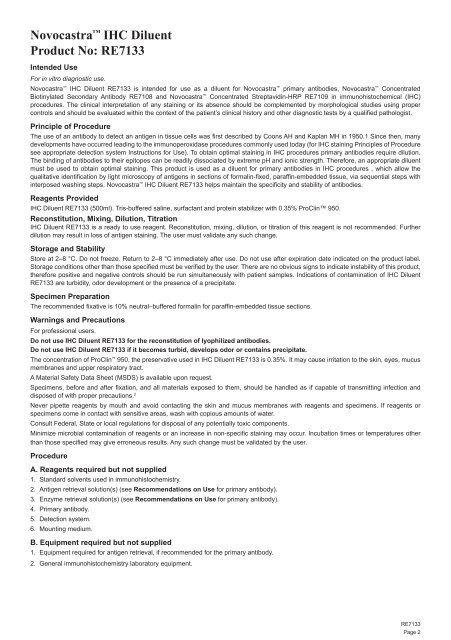Novocastra™ IHC Diluent
Novocastra™ IHC Diluent
Novocastra™ IHC Diluent
Create successful ePaper yourself
Turn your PDF publications into a flip-book with our unique Google optimized e-Paper software.
Novocastra <strong>IHC</strong> <strong>Diluent</strong><br />
Product No: RE7133<br />
Intended Use<br />
For in vitro diagnostic use.<br />
Novocastra <strong>IHC</strong> <strong>Diluent</strong> RE7133 is intended for use as a diluent for Novocastra primary antibodies, Novocastra Concentrated<br />
Biotinylated Secondary Antibody RE7108 and Novocastra Concentrated Streptavidin-HRP RE7109 in immunohistochemical (<strong>IHC</strong>)<br />
procedures. The clinical interpretation of any staining or its absence should be complemented by morphological studies using proper<br />
controls and should be evaluated within the context of the patient’s clinical history and other diagnostic tests by a qualified pathologist.<br />
Principle of Procedure<br />
The use of an antibody to detect an antigen in tissue cells was first described by Coons AH and Kaplan MH in 1950.1 Since then, many<br />
developments have occurred leading to the immunoperoxidase procedures commonly used today (for <strong>IHC</strong> staining Principles of Procedure<br />
see appropriate detection system Instructions for Use). To obtain optimal staining in <strong>IHC</strong> procedures primary antibodies require dilution.<br />
The binding of antibodies to their epitopes can be readily dissociated by extreme pH and ionic strength. Therefore, an appropriate diluent<br />
must be used to obtain optimal staining. This product is used as a diluent for primary antibodies in <strong>IHC</strong> procedures , which allow the<br />
qualitative identification by light microscopy of antigens in sections of formalin-fixed, paraffin-embedded tissue, via sequential steps with<br />
interposed washing steps. Novocastra <strong>IHC</strong> <strong>Diluent</strong> RE7133 helps maintain the specificity and stability of antibodies.<br />
Reagents Provided<br />
<strong>IHC</strong> <strong>Diluent</strong> RE7133 (500ml). Tris-buffered saline, surfactant and protein stabilizer with 0.35% ProClin 950.<br />
Reconstitution, Mixing, Dilution, Titration<br />
<strong>IHC</strong> <strong>Diluent</strong> RE7133 is a ready to use reagent. Reconstitution, mixing, dilution, or titration of this reagent is not recommended. Further<br />
dilution may result in loss of antigen staining. The user must validate any such change.<br />
Storage and Stability<br />
Store at 2–8 °C. Do not freeze. Return to 2–8 °C immediately after use. Do not use after expiration date indicated on the product label.<br />
Storage conditions other than those specified must be verified by the user. There are no obvious signs to indicate instability of this product,<br />
therefore positive and negative controls should be run simultaneously with patient samples. Indications of contamination of <strong>IHC</strong> <strong>Diluent</strong><br />
RE7133 are turbidity, odor development or the presence of a precipitate.<br />
Specimen Preparation<br />
The recommended fixative is 10% neutral–buffered formalin for paraffin-embedded tissue sections.<br />
Warnings and Precautions<br />
For professional users.<br />
Do not use <strong>IHC</strong> <strong>Diluent</strong> RE7133 for the reconstitution of lyophilized antibodies.<br />
Do not use <strong>IHC</strong> <strong>Diluent</strong> RE7133 if it becomes turbid, develops odor or contains precipitate.<br />
The concentration of ProClin 950, the preservative used in <strong>IHC</strong> <strong>Diluent</strong> RE7133 is 0.35%. It may cause irritation to the skin, eyes, mucus<br />
membranes and upper respiratory tract.<br />
A Material Safety Data Sheet (MSDS) is available upon request.<br />
Specimens, before and after fixation, and all materials exposed to them, should be handled as if capable of transmitting infection and<br />
disposed of with proper precautions. 2<br />
Never pipette reagents by mouth and avoid contacting the skin and mucus membranes with reagents and specimens. If reagents or<br />
specimens come in contact with sensitive areas, wash with copious amounts of water.<br />
Consult Federal, State or local regulations for disposal of any potentially toxic components.<br />
Minimize microbial contamination of reagents or an increase in non-specific staining may occur. Incubation times or temperatures other<br />
than those specified may give erroneous results. Any such change must be validated by the user.<br />
Procedure<br />
A. Reagents required but not supplied<br />
1. Standard solvents used in immunohistochemistry.<br />
2. Antigen retrieval solution(s) (see Recommendations on Use for primary antibody).<br />
3. Enzyme retrieval solution(s) (see Recommendations on Use for primary antibody).<br />
4. Primary antibody.<br />
5. Detection system.<br />
6. Mounting medium.<br />
B. Equipment required but not supplied<br />
1. Equipment required for antigen retrieval, if recommended for the primary antibody.<br />
2.<br />
General immunohistochemistry laboratory equipment.<br />
RE7133<br />
Page 2

















